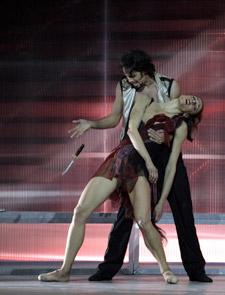A sexually rapacious woman, a prostitute and gypsy, someone with no rights who demands absolute freedom — the character Carmen, made famous by Bizet’s 1875 opera, gets a daring makeover in the North American premiere of Davide Bombana’s ballet Carmen with the National Ballet of Canada.
In the opera’s climax the beautiful, willful Carmen is stabbed to death by her spurned lover, Don José, as her new lover, the bullfighter Escamillo, slays a bull in the ring.
The Italian choreographer returned to the ballet’s source, the novella by Prosper Mérimée, to find new emotional and sexual power in the story’s drama.
“Reading the original,” says Bombana in his strong Italian accent, “I realized what actual characters Carmen and José are. Also how strong José is — not just Carmen who’s strong — he has this macho side, very Spanish. He looks at first more subdued than Carmen but he’s not. He wants to tame her, curb her… but he’s afraid of her sexuality.”
Bombana says he wanted to contemporize and universalize the story, strip out all the Andalusian clichés — the sun, the fans, the guitars — to pare down the story to the fatal attraction between Carmen and José. That meant breaking away from Bizet’s music. While much Bizet remains, some adapted for guitar, Bombana also uses Russian composer Rodion Shchedrin’s Carmen Suite and pounding percussion sections by the French ensemble Les Tambours du Bronx.
“I gathered all the Bizet arrangements that I was interested in and started to build a dramatic libretto. Again I wanted to avoid the clichés connected to the opera… so I used Tambours du Bronx for the extreme moments between José and Carmen.
“Loneliness plays an important part of my reading too,” he says. “The only thing that keeps them together is the sex; José and Carmen are both aware that everything else keeps them apart. That’s why they both have such an air of loneliness and why the carnality is so desperate. Their pas de deuxs are pretty violent.
“When they first dance together they zigzag through the room with no way of touching. And when they finally touch, immediately conflict starts.
“Loneliness on one side, desperate wanting on the other… and from that grows both the drama and the audience’s compassion for both characters.”
Bombana’s biggest change to the Mérimée/Bizet story was to take the metaphor of the bullfight — with its connections between sex and death, liberation and domination — and make it more explicit, much more explicit. He turns the character of Escamillo into the bull itself.
“It wasn’t enough to have Carmen sleep with Escamillo,” says Bombana. “One reason why I changed Escamillo into the bull — the symbol of masculinity, of male virility, what have you — is when Carmen sleeps with the bull, she’s betraying José with all mankind, the world.
“José feels squashed. Carmen’s sexuality makes him panic.”
The scene where Carmen has sex with the bull also features male toreadors in dresses dancing on pointe. “I wanted to relieve the tragedy, so I squished all the Spanish clichés into one scene, playing with Spanish machismo, having the toreadors become four big men in skirts carrying huge fans and flirting with the bull.
“I wanted the scene ironic, make it light… which was most difficult.”
Bombana created Carmen for Ballet du Capitole de Toulouse in 2006. The National’s opening night performance will feature Heather Ogden as Carmen, Noah Long as Don José, Robert Stephen as Garcia, Sonia Rodriguez as Michaela and Jonathan Renna as Escamillo. (The program also includes Dominique Dumais’ Skin Divers.)
“Even though my work is on pointe, it isn’t academic,” says Bombana. “I need dancers who are strong in classical technique but who can let go. I’ve followed the National for 20 years. It has a really strong classical tradition but the dancers work in the contemporary field with imagination.”


 Why you can trust Xtra
Why you can trust Xtra


